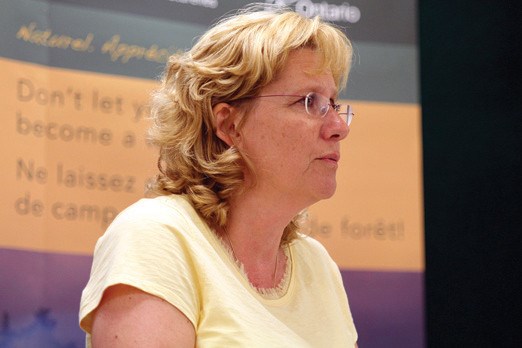Ontario’s Minister of Natural Resources doesn’t see the need to declare a state of emergency in Northwestern Ontario, even after taking to the air for an overhead view of the fires consuming the region’s forest and threatening several remote communities.
Linda Jeffrey on Thursday said the province has the situation under control, as it continues to battle as many as 112 wildfires blazing across the North.
“I have heard those calls,” Jeffrey said at a news conference held at the MNR’s Thunder Bay Fire Management Headquarters and Fire Service Centre.
But based on conversations with the cabinet committee of emergency management and people in the field, it’s not warranted, she added.
“We treat this as an emergency and we certainly have got emergency-area orders in place already, which restricts travel. We’ve got some restricted fire zones. We’ve got some measures in place that are managing the emergency nature of what’s happening,” Jeffrey said.
“All those things that would cause you to want to escalate the declaration are not in place. We’re getting full co-operation, we’ve got all the resources, things are working smoothly and those are the things I would use as a determination if it became more serious.”
MPP Howard Hampton (NDP, Kenora-Rainy River) was among those calling for more action by the province.
Hampton, who spent the past two days touring several of the affected communities, warned of a catastrophe if more effort isn’t put forth.
“These communities are asking for help from the province,” he said in a release issued by his office. “The leadership of the Nishnawbe Aski-Nation is asking for leadership from the province. Municipalities are asking for help from the province.”
Hampton added he believes emergency crews are working to the point of exhaustion.
However, MNR fire management supervisor Dave Manol said firefighters caught a bit of a break weather-wise on Wednesday, when rain storms hit the region.
But it may not be enough to save a community like Sandy Lake First Nation, where fires have crept to within 10 kilometres as evacuations continue, or Keewaywin First Nation, where the flames are within three kilometers and closing fast.
Manol said the fire did recede slight during the rains, but it only gives firefighters about a day to get in there on the ground and establish anti-fire lines.
“It’s provided a bit of relief, about 24 hours, however it didn’t put the fire out by any stretch of the imagination, especially that fire in Keewaywin, which will require boots on the ground to secure the lines so the threat to that community has been eliminated,” Manol said.
Between 2,700 and 3,300 people have been evacuated from the two communities, with more still trickling in through Thunder Bay before being transferred to other destinations in Ontario.
Sign in or register
- Messages
- Post a Listing
- Your Listings
- Your Profile
- Your Subscriptions
- Your Likes
- Your Business
- Support Local News
- Payment History
Registered Users
Already have an account?
New Users
Create a free account.
